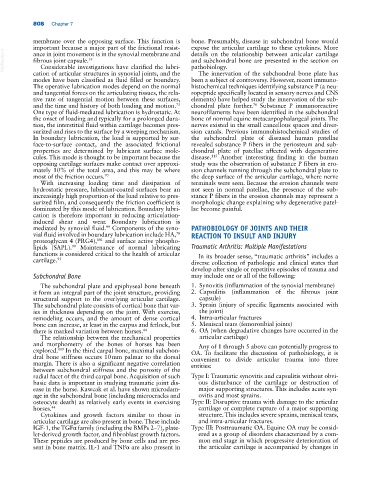Page 842 - Adams and Stashak's Lameness in Horses, 7th Edition
P. 842
808 Chapter 7
membrane over the opposing surface. This function is bone. Presumably, disease in subchondral bone would
important because a major part of the frictional resist expose the articular cartilage to these cytokines. More
VetBooks.ir fibrous joint capsule. 55 and subchondral bone are presented in the section on
details on the relationship between articular cartilage
ance in joint movement is in the synovial membrane and
Considerable investigations have clarified the lubri
pathobiology.
cation of articular structures in synovial joints, and the The innervation of the subchondral bone plate has
modes have been classified as fluid filled or boundary. been a subject of controversy. However, recent immuno
The operative lubrication modes depend on the normal histochemical techniques identifying substance P (a neu
and tangential forces on the articulating tissues, the rela ropeptide specifically located in sensory nerves and CNS
tive rate of tangential motion between these surfaces, elements) have helped study the innervation of the sub
and the time and history of both loading and motion. chondral plate further. Substance P immunoreactive
73
76
One type of fluid‐mediated lubrication is hydrostatic. At neurofilaments have been identified in the subchondral
the onset of loading and typically for a prolonged dura bone of normal equine metacarpophalangeal joints. The
tion, the interstitial fluid within cartilage becomes pres nerves existed in the small cancellous spaces and diver
surized and rises to the surface by a weeping mechanism. sion canals. Previous immunohistochemical studies of
In boundary lubrication, the load is supported by sur the subchondral plate of diseased human patellae
face‐to‐surface contact, and the associated frictional revealed substance P fibers in the periosteum and sub
properties are determined by lubricant surface mole chondral plate of patellae affected with degenerative
cules. This mode is thought to be important because the disease. Another interesting finding in the human
115
opposing cartilage surfaces make contact over approxi study was the observation of substance P fibers in ero
mately 10% of the total area, and this may be where sion channels running through the subchondral plate to
most of the friction occurs. 70 the deep surface of the articular cartilage, where nerve
With increasing loading time and dissipation of terminals were seen. Because the erosion channels were
hydrostatic pressure, lubricant‐coated surfaces bear an not seen in normal patellae, the presence of the sub
increasingly high proportion of the load relative to pres stance P fibers in the erosion channels may represent a
surized film, and consequently the friction coefficient is morphologic change explaining why degenerative patel
dominated by this mode of lubrication. Boundary lubri lae become painful.
cation is therefore important in reducing articulation‐
induced shear and wear. Boundary lubrication is
mediated by synovial fluid. Components of the syno PATHOBIOLOGY OF JOINTS AND THEIR
99
vial fluid involved in boundary lubrication include HA, REACTION TO INSULT AND INJURY
78
101
proteoglycan 4 (PRG4), and surface active phospho
lipids (SAPL). Maintenance of normal lubricating Traumatic Arthritis: Multiple Manifestations
99
functions is considered critical to the health of articular In its broader sense, “traumatic arthritis” includes a
cartilage. 95 diverse collection of pathologic and clinical states that
develop after single or repetitive episodes of trauma and
Subchondral Bone may include one or all of the following:
The subchondral plate and epiphyseal bone beneath 1. Synovitis (inflammation of the synovial membrane)
it form an integral part of the joint structure, providing 2. Capsulitis (inflammation of the fibrous joint
structural support to the overlying articular cartilage. capsule)
The subchondral plate consists of cortical bone that var 3. Sprain (injury of specific ligaments associated with
ies in thickness depending on the joint. With exercise, the joint)
remodeling occurs, and the amount of dense cortical 4. Intra‐articular fractures
bone can increase, at least in the carpus and fetlock, but 5. Meniscal tears (femorotibial joints)
there is marked variation between horses. 44 6. OA (when degradative changes have occurred in the
The relationship between the mechanical properties articular cartilage)
and morphometry of the bones of horses has been Any of 1 through 5 above can potentially progress to
explored. In the third carpal bone, maximal subchon OA. To facilitate the discussion of pathobiology, it is
119
dral bone stiffness occurs 10 mm palmar to the dorsal convenient to divide articular trauma into three
margin. There is also a significant negative correlation entities:
between subchondral stiffness and the porosity of the
radial facet of the third carpal bone. Acquisition of such Type I: Traumatic synovitis and capsulitis without obvi
basic data is important in studying traumatic joint dis ous disturbance of the cartilage or destruction of
ease in the horse. Kawcak et al. have shown microdam major supporting structures. This includes acute syn
age in the subchondral bone (including microcracks and ovitis and most sprains.
osteocyte death) as relatively early events in exercising Type II: Disruptive trauma with damage to the articular
horses. 44 cartilage or complete rupture of a major supporting
Cytokines and growth factors similar to those in structure. This includes severe sprains, meniscal tears,
articular cartilage are also present in bone. These include and intra‐articular fractures.
IGF‐1, the TGFα family (including the BMPs 2–7), plate Type III: Posttraumatic OA. Equine OA may be consid
let‐derived growth factor, and fibroblast growth factors. ered as a group of disorders characterized by a com
These peptides are produced by bone cells and are pre mon end stage in which progressive deterioration of
sent in bone matrix. IL‐1 and TNFα are also present in the articular cartilage is accompanied by changes in

